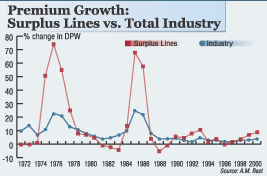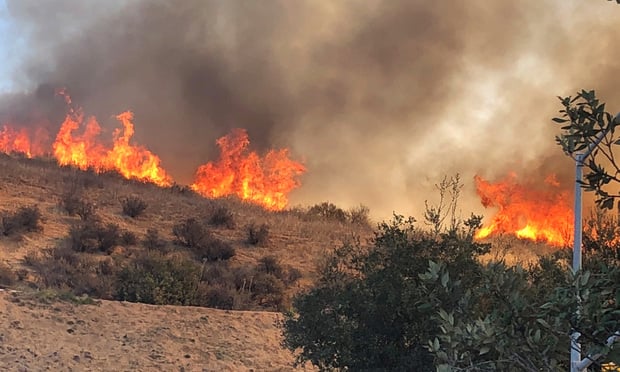WTC Attack To Hike Surplus Submissions
Surplus lines insurers are unlikely to feel the immediate impact of the World Trade Center disaster that standard insurers will, but they may face a surge of submissions as a result of the tragedy, according to an insurance analyst.
“The E&S exposure from the World Trade Center events, on the claims side, is going to be way low compared to the standard market,” Ralph Cagnetta, managing senior financial analyst for A.M. Best in Oldwick, N.J., told National Underwriter during a recent interview.
Most of the large-limit policies, workers comp and preferred business interruption business that will result in claims, were written on an admitted basis, he said, predicting only “isolated exposure for some surplus lines companies.”
The most significant effect on the surplus lines market, he said, will be the “more powerful wave of business [that will be] heading their way.” As large commercial writers review underwriting practices, surplus lines insurers are going to be asked to quote a lot more of the business that they hadn't seen before, he explained.
Mr. Cagnetta, the primary author of a recently-released A.M. Best report on the financial health of the surplus lines market, based his comments on opinions of “prominent” surplus lines executives he called to respond to the question. Based on his knowledge of the market, he said he agreed with their initial assessments.
 For the eighth consecutive year, insurance rating agency A.M. Best issued its annual report on the excess and surplus lines industry, finding its financial performance and solvency measures “on par” with the admitted market.
For the eighth consecutive year, insurance rating agency A.M. Best issued its annual report on the excess and surplus lines industry, finding its financial performance and solvency measures “on par” with the admitted market.
But in spite of posting a direct premium growth rate nearly double the rate for the entire property-casualty industry in 2000, the rating agency doesn't foresee improving operating results for either group in 2001, according to the report and a recent six-month analysis of the p-c industry released separately.
The report, like seven prior ones, was commissioned by the Derek Hughes/ NAPSLO Education Foundation, which was formed by the Kansas City, Mo.-based National Association Of Professional Surplus Lines Offices, Ltd. in 1991. Published prior to attacks on the World Trade Center and the Pentagon, it was scheduled to be distributed at the NAPSLO annual meeting, which was cancelled in the wake of the tragedy.
While direct premiums for surplus lines insurers rose 9.8 percent in 2000, “rising loss cost trends and increasing reinsurance costs will serve to somewhat offset improving operating margins in 2000 and 2001,” the rating agency said.
The 9.8 percent jump was the biggest since a 13.1 percent climb in 1993. And business is continuing to move back into the surplus lines market, the report said, citing information from stamping offices and commentary from surplus lines underwriters and brokers.
 Still, “Best feels that conditions that ledto a prolonged soft marketpersist in today's environment,” the report said, citing the presence of excess capital and too many players among them.
Still, “Best feels that conditions that ledto a prolonged soft marketpersist in today's environment,” the report said, citing the presence of excess capital and too many players among them.
In spite of double-digit increases on commercial lines renewal business, “new business remains competitive and pricing is less robust,” the report said.
Subtle differences in the language of reports issued this year and last year suggest an outlook dimmer than one might expect to find described in the first report on the surplus lines industry in recent years to finally confirm the unquestioned presence of a hardening market.
Careful readers, for example, will not find a section headed “Strong Financial Condition” in the report's executive summary this year. Instead, the heading, which appeared in the 2000 report, simply reads “Financial Condition of the Market” for 2001.
And the text of the 2001 report describing the “financial condition” now tells readers that “underwriting results achieved by the surplus lines market have weakened in recent years,” citing a reduced amount of favorable reserve development on prior accident years as a main cause of the deterioration.
Still, underwriting results for a surplus lines market composite (of 66 companies writing $5.9 billion in direct premiums in 2000) were better than the industry for 2000 and over the last five years. The composite 2000 combined ratio of 103.4 beat the industry by seven points, Best said, with nine points separating the groups, on average, over the last five years.
Mr. Cagnetta sees such favorable comparisons for surplus lines insurers as the most important findings in the study.
“Despite challenges faced by E&S companies, such as competition from the admitted market and regulatory challenges, the surplus lines market does continue to maintain a high level of financial strength and solid operating results, which are supported by sound underwriting guidelines and effective risk management techniques,” he said.
“Our median rating for surplus lines writers continues to be 'A,' which compares favorably to the standard market, which has a median rating of 'A-minus,'” he added. “We would attribute the more favorable rating to demands by the marketplace that E&S carriers maintain a higher level of capital,” he explained, adding that “E&S writers tend to operate with more conservative operating leverage and more disciplined underwriting.”
The median surplus lines rating that Mr. Cagnetta referred to is for 91-rated “domestic professional surplus lines companies.” Best classifies companies that write more than one-half their direct premiums on a non-admitted basis as domestic professional surplus lines companies. (Non-admitted business is written by an insurer not licensed where the risk is located, but placed through a licensed surplus lines broker.)
As in prior years, Best's analysis shows surplus lines insolvency rates mirroring those of traditional insurers over a long time span, with both groups showing an average failure frequency of 0.86 percent from 1972-2001. In each of the last four years, however, insolvency rates for surplus lines insurers were higher.
While the report cites insolvencies of several Illinois Insurance Exchange syndicates in 1996-1999 as one cause of higher recent failure rates, the report doesn't include any companies in the Frontier Insurance Group in either failure count. Last year's report classified three Frontier companies as surplus lines, including Frontier Pacific Insurance Company, which was conserved by California's insurance commissioner after the Best report was compiled.
The “complexion” of the surplus lines market has changed significantly as a result of Reliance's insolvency and the exits for Frontier and the Acceptance Insurance Companies of Omaha, Neb., the report said. The surplus lines failure count includes two companies in Reliance Insurance Group, while six others are in the admitted total.
In what Best calls a “market increasingly dominated by large players,” some consolidation activity has also changed the Best's lineup of the leading 25 surplus lines groups. Travelers, which now includes companies once in the Associates Capital Group, made the biggest leap–to 7th place from 25th last year
Exits and consolidations made room for five new entrants to the top 25 groups listed in the Best report–RLI, Western World, GE Capital, Front Royal and PMA Capital Corp.
Reproduced from National Underwriter Property & Casualty/Risk & Benefits Management Edition, September 21, 2001. Copyright 2001 by The National Underwriter Company in the serial publication. All rights reserved.Copyright in this article as an independent work may be held by the author.
Want to continue reading?
Become a Free PropertyCasualty360 Digital Reader
Your access to unlimited PropertyCasualty360 content isn’t changing.
Once you are an ALM digital member, you’ll receive:
- Breaking insurance news and analysis, on-site and via our newsletters and custom alerts
- Weekly Insurance Speak podcast featuring exclusive interviews with industry leaders
- Educational webcasts, white papers, and ebooks from industry thought leaders
- Critical converage of the employee benefits and financial advisory markets on our other ALM sites, BenefitsPRO and ThinkAdvisor
Already have an account? Sign In Now
© 2025 ALM Global, LLC, All Rights Reserved. Request academic re-use from www.copyright.com. All other uses, submit a request to [email protected]. For more information visit Asset & Logo Licensing.








